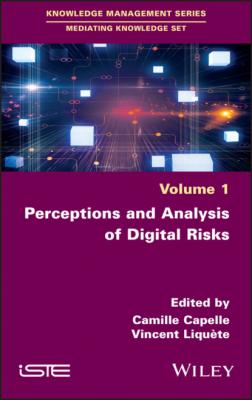Perceptions and Analysis of Digital Risks. Группа авторов
Чтение книги онлайн.
Читать онлайн книгу Perceptions and Analysis of Digital Risks - Группа авторов страница 5
 189
189
199 190
200 191
201 193
202 194
203 195
204 196
205 197
206 198
207 199
208 201
209 202
210 203
211 204
212 205
213 206
214 207
215 208
216 209
217 210
218 211
219 212
220 213
221 214
222 215
223 216
Mediating Knowledge Set
coordinated by
Anne Lehmans and Vincent Liquète
Volume 1
Perceptions and Analysis of Digital Risks
Edited by
Camille Capelle
Vincent Liquète
First published 2021 in Great Britain and the United States by ISTE Ltd and John Wiley & Sons, Inc.
Apart from any fair dealing for the purposes of research or private study, or criticism or review, as permitted under the Copyright, Designs and Patents Act 1988, this publication may only be reproduced, stored or transmitted, in any form or by any means, with the prior permission in writing of the publishers, or in the case of reprographic reproduction in accordance with the terms and licenses issued by the CLA. Enquiries concerning reproduction outside these terms should be sent to the publishers at the undermentioned address:
ISTE Ltd
27-37 St George’s Road
London SW19 4EU
UK
John Wiley & Sons, Inc.
111 River Street
Hoboken, NJ 07030
USA
© ISTE Ltd 2021
The rights of Camille Capelle and Vincent Liquète to be identified as the authors of this work have been asserted by them in accordance with the Copyright, Designs and Patents Act 1988.
Library of Congress Control Number: 2021946232
British Library Cataloguing-in-Publication Data
A CIP record for this book is available from the British Library
ISBN 978-1-78630-744-6
Foreword
A complex and indeterminate digital environment brings uncertainty to our everyday decisions and the risks that can result from them. Resolving this uncertainty, and adapting to an environment that bears different risks, questions the very perception we have of it. In the world of education, the way we learn to learn in an open digital world and the risks we encounter are orchestrated. Concerns about digital risks have come to constitute the cornerstone of our relationship to information and relevant educational issues. The risks that teachers and students associate with their information environment, the pitfalls encountered and the strategies proposed can be examined. Between aversion, avoidance, recommendations or resolution, a “relationship to risk” – a specific educational approach – is constructed in the informational and professional sphere. A “notion” of risk, which goes beyond the risks themselves, has become an approach associated with and accompanying digital practices in education. The need for understanding is associated with vigilance and the project of teaching informational risks. Research on digital risks in an educational and professional context is as much about the risk paradigm as it is about the informational uses associated with how they are perceived.
The notion of risk
The risk model brings to the fore the perception of an event that may occur, in “a future that may happen” (Beck 1986), which is not fully within our control. This event is sensed (and is not yet happening or real) as a danger that we must anticipate by picturing it and taking precautionary measures. This becomes a reverse causation of our action. Paradoxically, we tend to ask ourselves: how can we avoid the risks (even though it is the awareness of the risk which can ward off danger)? The perception of risk(s) then becomes a situation whereby the activity is associated with its uncertainties. Risk is distinct from danger, whose probability it relates to; it is distinct from the sole threat insofar as it is nourished by the perceptions that we have of it. Thus, for Ulrich Beck, at the heart of a civilization of risk, “risk has become the measure of our action”1. He describes the evolution of human and political action, linked to “scientific–technical–economic modernization”, as a response to the disorders resulting from its development (industry, environment, economy, etc.). Risk does not designate danger; it constitutes the answer in line with an analysis or a preventive action. It becomes a model for the development of human conduct, a reason for action. For Beck, risk is integrated into a positive culture. With reference to “emancipatory catastrophe”, he calls for new regulations of the human mind by making it the principle of an anticipatory consciousness and of an action that supposes taking risks. “Risk”, for Beck, is not only the danger but also its perception and a critical modality that calls for a positive culture of change and a reflexive steering of action. Digital risks, associated with the socio-technical modernity described by Beck, are new challenges that require the construction